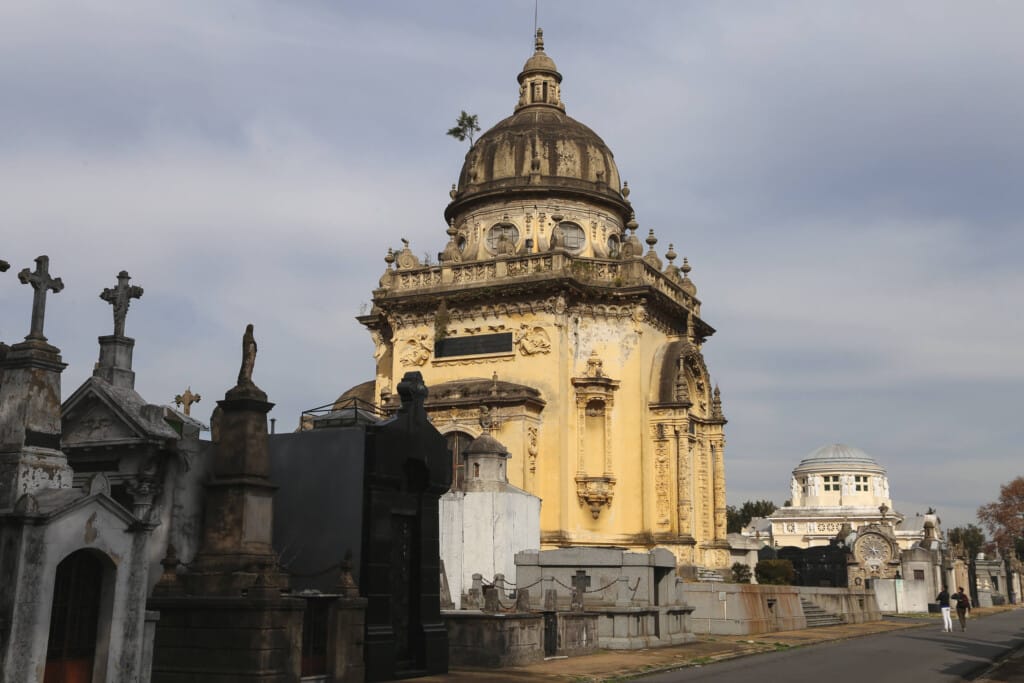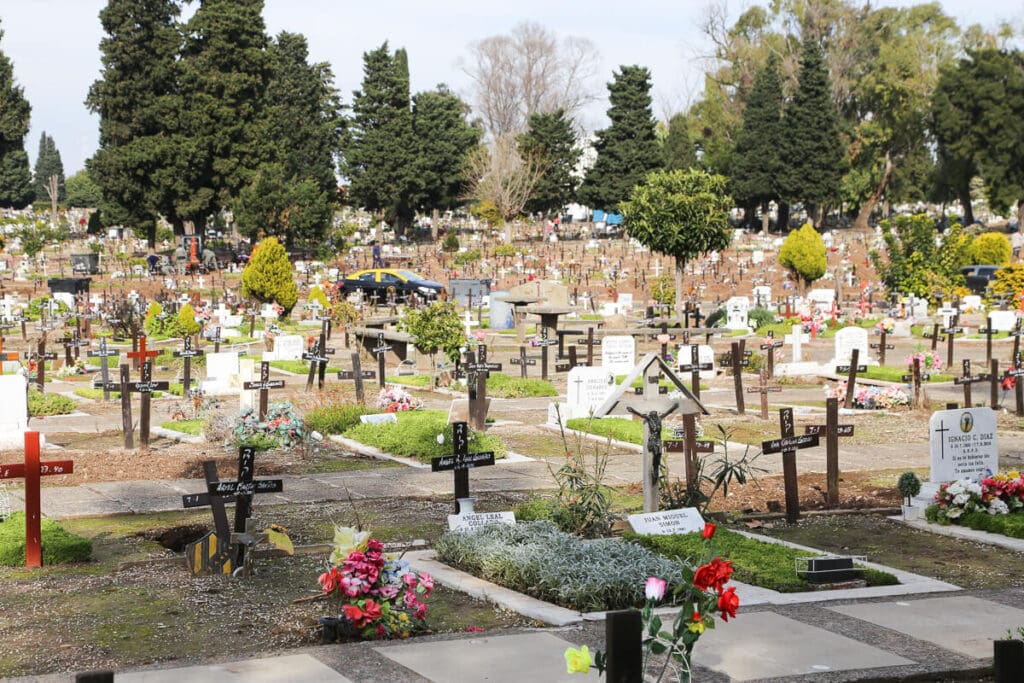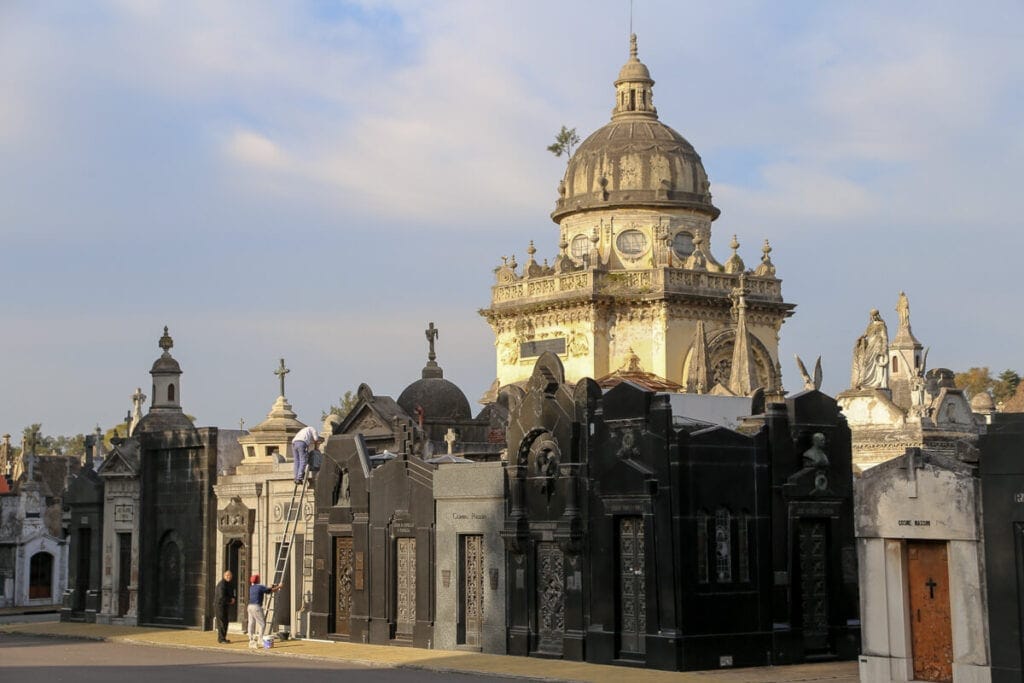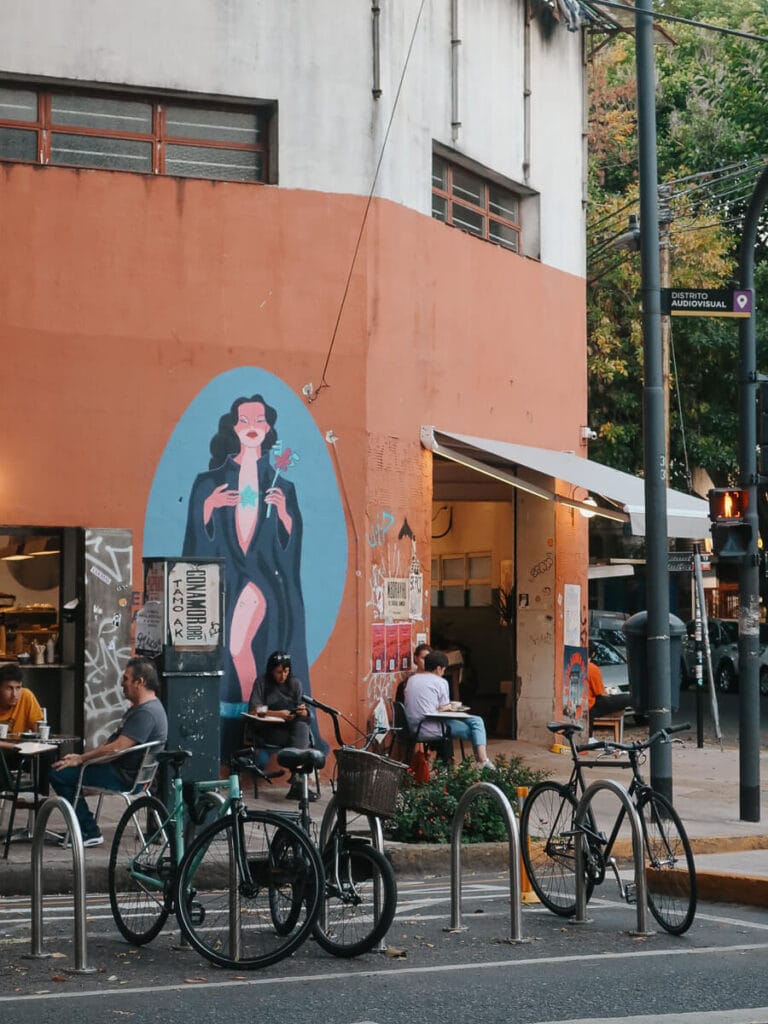As a neighborhood, no other barrio has changed more than Chacarita has in the short time since I began this blog back in 2017.
I first wrote this guide in 2018 and it started out with: “Chacarita isn’t a neighborhood on most tourist’s Buenos Aires itinerary.“
Today, Chacarita is where the stylish new boutiques and creative chefs choose for their new ventures.
Chacarita now ticks all the boxes that Palermo Soho used to dominate: cafes de especialidad, boutique shopping, and new restaurant openings.
Unlike Palermo Soho, however, Chacarita remains a largely working class neighborhood.
Being home to the city’s main cemetery and a large train station/transportation hub, Chacarita cannot change completely.
With one day in Chacarita you can see two sides of Buenos Aires: sourdough pastries and pricey filtered coffee with a side of expertly curated boutiques followed by a slice of perfectly greasy pizza for lunch dished up by a 70 year old waiter and a stroll through the people’s cemetery.
Even the New York Times say Chacarita, Get There Soon, so what are you waiting for?

QUICK NOTE: This post contains affiliate links and Sol Salute may receive a commission for purchases made through these links, at no extra cost to you.
A Neighborhood Guide: Chacarita, Buenos Aires
How much time to budget for Chacarita?
I’d allow half a day, ideally spending the morning touring the cemetery and exploring the surrounding streets.
Follow it up with lunch at one of the classic local spots or newer restaurants nearby.
Top it off with coffee at a historic cafe that doubles as a photography museum.
Afterward, you have the rest of your afternoon free.
Or… visit in the afternoon and end with a happy hour vermouth that bleeds into dinner!
If you want to continue exploring the residential neighborhoods, Colegiales is a beautiful neighborhood just a few streets away.
Prefer more boutique shopping? Take a taxi to Palermo Soho.
Want to stay off the beaten path? Then take the metro B Line to the Carlos Gardel stop to explore Almagro.
Chacarita Tours
Exploring a new area with a guide is never a bad idea – you’ll discover places you never would alone and get history and context to flesh out your visit.
Here are three excellent tours of Chacarita:
- Walking Tour/Cemetery – The cemetery is enormous and filled with history, go on a tour of the neighboring Parque de los Andes and the cemetery with an informed guide. You won’t regret it.
- Chacarita & Vermout – Visit four restaurants while sampling the local specialty – vermouth – and learning fascinating history about the barrio. 💸 Use code SOLSALUTE to save 10%!
- Cooking Class – Most cooking classes in BA involve empanadas, but this one focuses on pasta. Learn how to make pasta from scratch the Argentine way in a traditional Chacarita home.

El Cementerio de Chacarita: History of a Neighborhood & How to Visit
While today Chacarita is a transit center and the epitome of urban chaos, nearly 200 years ago this area was the countryside that lied to the north of Buenos Aires.
The name Chacarita comes from the word “chacra”, which means a small farm.
This area was home to a Jesuit school and its “small garden,” or chacrita or chacarita.
In 1871 things took a turn for the worse, there was a yellow fever outbreak that wreaked havoc in southern neighborhoods like La Boca.
The city was forced to create a new cemetery in what is currently the Los Andes Park (a city park that’s located outside the current walls of today’s cemetery) for the yellow fever victims.
There were so many victims to the outbreak, a tranvia (actually called the Funeral Tram or Tranvía Fúnebre) and a new train station with the same name, Funeral Station.
The cemetery wasn’t particularly hygienic and cremated up to 564 cadavers in one day.
Imagine living next to that.
Due to protests from neighbors, the city shut down the cemetery in 1875.
In 1887, construction began on the New Chacarita Cemetery, which is the cemetery you see today.
It’s massive, at 96 hectares (237 acres!), occupying a huge space in the center of a densely populated city.
First, you’ll see mausoleums and pantheons similar to (and much larger than) those in Recoleta.
Next are crypts and niches.
TIP: This cemetery is huge. As in, much larger than you’re imagining in your head. Book this guided tour to add context to your visit and to avoid aimless wandering, you won’t regret it.

Two stories underground, there are 9 of these underground niche crypt-like burials.
Finally, are the graves or land burials. Citizens are interred here for 10 years. Then they’ll then be removed and re-buried in a “niche” or crypt.

Famous Inhabitants: Tango Stars in Chacarita
Recoleta may be where the city’s politicians and military heroes are laid to rest, but Chacarita is where the people’s celebrities are buried.
There are pantheons that house hundreds and even thousands of coffins.
Many of these pantheons belong to unions, and the most famous is the Artists’ Pantheon. Musicians, actors, they were all buried here.
You can find it at the end of the diagonal street that cuts through the mausoleums to your right when you first enter the cemetery.
Many fans came to pay homage to their idols but weren’t able to enter the pantheon.
They resolved this by creating “Artist’s Corner” (Rincon del Artista), located by the land plots (in the 7th sector).
The city moved famous tango musicians, artists, and actors from their original resting place to be displayed here.

I understand why they did this, these artists are iconic and people want to pay homage to their heroes.
That said, it’s a bit of a strange experience. Something about it all feels a bit, strange, I can’t think of a better word.
The country’s most famous dead arranged in a circle, to be mourned in mass.
But, if you’re looking to see the graves of Pugliese, Troilo, and Quinquela, they’re all conveniently located together!

Carlos Gardel
Standing apart, buried in a mausoleum of his own, is Argentina’s most famous musician.
Carlos Gardel is a tango legend, any tango song you hear in any movie worldwide is likely by Gardel (and it’s probably Por una cabeza).
He never married or had children, so Gardelianos, his fans, maintain his grave.
Find his grave at the corner of streets 6 and 33 (Google Maps can help you find it if you understandably get lost here).
Gardel died young, in a plane accident in Colombia. The effort to bring his body back home was no small undertaking.
The only way to bring a cadaver at that time was by boat. He was sent first to New York where he was transferred to a boat that brought him home to his Buenos Aires querido.
The entire process took a year.
When he was finally laid to rest in Chacarita, the funeral procession through the city was massive. Crowds filled Corrientes Avenue and the cemetery (many even climbing on top of the roofs of the mausoleums).

Jorge Newberry
Jorge Newberry – you may recognize this name from the domestic airport in Palermo.
Newberry was an engineer and aviator. He was the first to fly across the River Plate in 1912.
He died suddenly in 1914 in Mendoza preparing for his first attempt to cross the Andes.
A woman asked him to fly, so he borrowed a plane from a friend (who warned him of problems with the wing).
After some aerobatics, the plane violently crashed.
At his grave is a monument. It’s Icarus, who flew too close to the sun, with Newberry’s face. He is lying at the foot of a boulder, which represents the Andes.

Chacarita Cemetery Tours
I highly recommend going on a guided tour.
Don’t underestimate the immensity of this cemetery.
Book this tour to visit the cemetery with context and learn the history of those who rest here, as well as surrounding sites.
Alternatively, if you’re flexible on time and speak Spanish, the city government offers free tours of the cemetery on the 2nd and 4th Saturdays of each month, at 10 am.
It says it’s one hour, however, ours lasted two and a half hours (it’s HUGE and our guide had a lot to say).
Things to do in Chacarita
Beyond the cemetery, which behemoth size and importance we’ve already covered, what else is there to do here?
Bar Palacio/Photography Museum Simik
📍Av. Federico Lacroze 3901

Bar Palacio, a Chacarita institution since 2001, is a triple thread – photography museum meets cafe meets jazz club.
Alejandro Simik was a firefighter with a passion for photography.
He studied photography and visited markets, antique fairs, and estate sales to slowly amass a large collection of antique cameras.
In 2001, he decided to open a photography museum with his collection in a bar he owned.
And if classic bar and photography museum wasn’t enough, on certain nights of the week Bar Palacio hosts jazz performances, check their Instagram for the schedules.
TIP: If you’re only interested in the museum, it’s free to visit and you aren’t required to consume anything in the bar to have a look around the exhibits.
Feria Parque Los Andes
📍Av. Corrientes 6400
Parque Los Andes, the park in front of the cemetery, comes to life on the weekend with the Feria Parque Los Andes.
On Saturdays, Sundays and holidays, more than 500 stands surround the park with new and used items both but it’s the used that stands out.
This is paradise for vintage and antique lovers but you need to be have patience and a discerning eye.
Among a lot of junk is a lot of treasure with a mix of vintage clothing, antiques and jewelry.
Visiting in the Spring? In November, Jacaranda trees bloom purple all over Buenos Aires and Parque Los Andes is one of the most beautiful places to see them!

Gauchito Gil Shrine
📍Av. Corrientes 6400
Gauchito Gil is a legendary figure in Argentina, not recognized by the Catholic church, he is a popular saint, receiving prayers from those in need.
Originally from Corrientes, he has the reputation of a Robin Hood figure who always gave to the poor.
The story and legend surrounding him is long and if you’re interested, I’ve written about Gauchito Gil & Other Popular Saints.
In Parque Los Andes at Av. Corrientes 6400, there is a shrine dedicated to him under a large tree.
Devotees bring offerings of wine, cigarettes, light candles and even dance to traditional folkloric music in his honor.


Shop in the boutiques
Ring the bell at Falena Libros to pass the exposed brick exterior into a cultured oasis.
This book shop and wine bar is impossible to detect from the street but you’ll settle right in with a glass of Naranjo wine and a new book.
Facon is a paradise for tourists and cultured locals alike. Martin Bustamente tours the country, visiting a well curated list of local artisans to select only the best items for the shop.


Where to eat in Chacarita
Let’s be honest, the best thing to do in Chacarita is to eat.
The main reason I keep finding myself in Chacarita time and time again is for dinner.
Argentine pizza is a hot topic among tourists who either love it or hate it (I love it). I find the secret is to try the right slice. Each location has a specialty and here it is fugazzetta (a decadent cheese and onion pizza).
The two Chacarita pizzerias opened in front of the train station in the same year, 1947, one right next to the other.
El Imperio de la Pizza and La Pizzería Santa María are virtually identical in decor, menu, and vibes.
Read more: A Guide to the Best Pizza in Buenos Aires
Another Chacarita icon is Albamonte, one of the best Buenos Aires bodegones that’s famous for its pasta.
And we’ve already mentioned it but it bears repeating, if you’re looking for a traditional cafe with a twist, go to Bar Palacio to have a coffee amidst their quirky camera museum.


Now that we’ve hit up the cornerstones of Chacarita cuisine, here are some of the newcomers and coolest Buenos Aires cafes that are putting this barrio on everyone’s radars.
Below is a list of my favorites but it is not exhaustive (I simply can’t keep up).
Avenida Jorge Newberry is the main drag with endless restaurants and boutiques. Can’t decide where to go? Have a wander here!
- Sifon Soderia – This is my favorite in the area, the menu features small plates best enjoyed shared. Dishes are traditional Argentine staples like spinach fritters and oxtail empanadas, just like abuela made. And the cocktails heavily feature vermouth and soda, just like grandpa made.
- Georgie’s – Taco heaven.
- Maure – Steak heaven (reserve in advance, seating is limited).
- Tita La Vedette – 100% plant based pastas
- Condarco – Cozy corner dishing up classic dishes done exceedingly well with an impressive wine list.
- Cuervo – Hipster specialty coffee shop, best avocado toast in town.
And for Michelin recognized restaurants in Chacarita, read my Buenos Aires Michelin Guide on how to get a table, what to order, and more.
Chacarita Map
Argentina Travel Resources
- BOOK A CONSULTATION | I offer one-on-one travel consultations to help you plan your trip to Argentina. Pick my brain to get a local’s insight. Click here for more information.
- MY MAP | Buy my interactive map with 300+ pins to have access to the city as I see it. It is an invaluable resource. See more here about how it works.
- AIRPORT TRANSFERS | Having a driver waiting for you is ideal for a stress free arrival, Cesar and his team here is the best option for a driver from Ezeiza or Aeroparque, they are my go-to airport ride!
- TRAVEL INSURANCE | Always travel insured. Anything can happen anywhere and it is scarier and costlier in an unfamiliar country. SafetyWing’s Essential Plan covers unexpected travel and medical emergencies and even offers add-ons like electronics theft or adventure sports. It is the best if you’re coming on vacation. If you’re coming as a digital nomad or an extended stay, you need their Complete Nomad Plan which also covers routine check ups, maternity, mental healthcare and more. Read more: Health Insurance in Argentina
- PHONE PLAN | These days, traveling with data is essential. Especially in Argentina where everything is managed on Instagram and WhatsApp. I recommend this E-SIM card. It’s hassle-free and affordable, for more read how to get an Argentina sim card.
- ACCOMMODATION IN ARGENTINA | booking.com is the most common hotel site used in Argentina and it’s where you’ll find the most options.
- RENTAL CARS | I love using Discover Cars, it is a great platform to compare different rates and providers and I find they have responsive customer service.
- BUS TICKETS | Check Busbud for long distance bus routes and tickets.
- VPN | If you’ll be using a public WiFi connection and want to secure your data, I highly recommend using a VPN, I personally use and have had a good experience with ExpressVPN. I also use it to access Hulu and American Netflix from Argentina.
- FLIGHTS | Always check Google Flights and Skyscanner for flights to and within Argentina. Aerolineas Argentina is the local airline with the most routes. FlyBondi and Jetsmart are two budget airlines with dirt-cheap prices (but expect to pay for every add-on like luggage).

